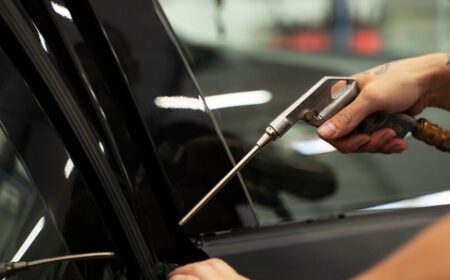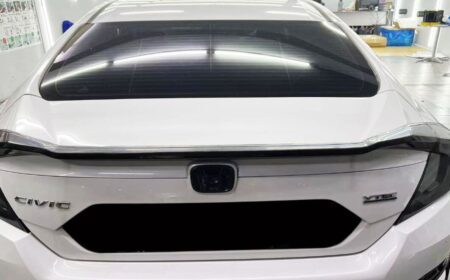
Reflective and non-reflective car window tints offer more than simply a cosmetic boost to Singapore vehicle owners; they also provide functional benefits that can improve the driving experience. In Singapore’s crowded city streets and year-round tropical climate, motorists increasingly turn to window tinting options to manage the heat and maintain privacy.
Key highlights: Car window tinting in Singapore and Malaysia
Reflective vehicle tints have a metallic shine that looks good and deflects harmful sunlight and UV rays, keeping automobiles cool in Singapore’s hot weather. This cooler environment reduces air conditioning consumption, improving fuel economy. Reflective window tints provide daytime privacy and heat comfort while reducing nighttime visibility due to their mirror-like surface. At night, these reflective coatings can obstruct clear vision from inside the vehicle. Alternatively, non-reflective tints absorb sunlight with dyed films to provide consistent seclusion and good vision both during the day and at night. These variations block some light, protect against UV rays, and keep the car’s interior cool without the high reflectivity of metal coverings.
A comparison of reflective and non-reflective car window tints.
When choosing automobile window tinting services, owners frequently balance the advantages and disadvantages of reflective versus non-reflective tints. Both have the primary goal of lowering the quantity of sunlight that enters the car, resulting in cooler interior temperatures and greater privacy. However, significant variances can influence a driver’s decision based on their needs and preferences.
Reflective automobile window tints have a bright, mirror-like look and reflect sunlight better than non-reflective tints. One of the primary advantages of this type of automotive tint is its improved ability to block out sun rays, resulting in excellent heat rejection and a more stable interior temperature. Reflective tints also improve privacy by making it more difficult to see into the automobile from the outside. These advantages, however, may be offset by disadvantages. The reflective surface can occasionally cause glare for other drivers, which might be considered a safety risk. Furthermore, these tints may not necessarily comply with local standards; for example, LTA-approved automobile solar films in Singapore have strict rules governing how reflective and dark a tint can be.
Matte-finished, non-reflective automobile tints, on the other hand, have a subtle beauty while blocking UV rays and decreasing glare. These less visible tints, made from colored materials, absorb solar heat rather than reflecting it, resulting in a cooler vehicle interior. They may not be as heat-resistant as reflective films, but they are frequently chosen because they comply with tight vehicle window tinting regulations. In Singapore, these widely accessible tints are the preferred option for drivers seeking both style and compliance.
Today’s vehicle solar film solutions incorporate advanced technology that meets aesthetic and performance requirements. In cities like Singapore, where tight laws must be observed, both kinds exist in LTA-approved vehicle solar film varieties, allowing drivers to reap the benefits of car window tinting without legal ramifications.
The advantages and disadvantages of reflective and non-reflective car window tints:
Pros of using reflective window tints:
- Reflective tints are great at reflecting sunlight, significantly reducing the heat entering the vehicle.
- They can shield many damaging UV rays, preventing the car’s interior from deteriorating and lowering the danger of skin damage.
- Reflective tints can provide privacy during the day by making it more difficult for people to see inside the car.
- They aid in decreasing glare from the sun and headlights, improving driving comfort and safety.
- Some vehicle owners enjoy the mirror-like appearance of reflective tinting because it is sleek and distinctive.
Cons of using reflective window tints:
- At night, reflecting tints might make it difficult for the driver to see outside, thus jeopardizing safety.
- Singapore has restrictions governing how reflective or dark tints can be, and highly reflective tints may be illegal.
- The vehicle’s gleaming appearance may attract extra attention, which isn’t necessarily good.
- Over time, the reflective layer may erode, resulting in a less effective and less appealing tint.
Pros of using non-reflective window tints:
- Non-reflective tints provide a more subdued and traditional appearance, commonly favored for personal or professional automobiles.
- Non-reflective tints, like reflective tints, can filter heat and ultraviolet rays, albeit to a lesser level.
- They are less likely to violate municipal window-tinting restrictions.
- Non-reflective tints usually provide better visibility at night than reflective tints.
Cons of using non-reflective window tints:
- They may not reflect heat or reflective tints.
- Non-reflective tints may fade over time due to sun exposure, necessitating replacement or re-tinting.
- These shades may offer less privacy during the day than reflective tints.
Conclusion
In Singapore, automotive tinting options range from reflective to non-reflective films. The reflective variant excels at blocking solar heat and UV rays while increasing seclusion, whereas the non-reflective tints combine subtlety and conformity with local regulations. Despite their benefits, reflecting tints can impair nighttime visibility and draw regulatory scrutiny; non-reflective tints enable regulatory compliance and improved night driving but may jeopardize daytime privacy. Car tinting in Singapore offers a customized solution for each driver, balancing style, comfort, and legal requirements.

